Author: Iris
Tenno Tanjobi
Today was a national holiday in Japan – the emperor’s 80th birthday. His Imperial Majesty the Emperor Akihito was born on December 23rd, 1933 in Tokyo as the fifth child but first son of emperor Showa (Hirohito). He ascended to the throne on January 7th, 1989, with the official enthronement taking place on November 12, 1990 after 22 months of preparations. His era bears the name Heisei.
I have not noticed anything big going on in Kyoto (I didn’t go downtown though), but tenno tanjobi is one of only two days (the other one is January 2nd) when the general public is allowed to enter the Imperial Palace in Tokyo. You may then even write a greeting to the emperor and as this page states “The Greeting Book will be duly forwarded to its highest destination as the expression of your warm congratulations” there could even be a chance of him reading it! This year, there were three appearances of the emperor and his immediate family planned on a balcony of one of the palace buildings and people go there and wave little Japanese flags to greet the emperor. This year, there were about 24.000 visitors, and as the entrance gates close after only two hours, you can imagine how terribly crowded the plaza must have been on which the people waited for the emperor…
Happy Birthday, Your Majesty!
Postcards
Today, I wrote a few nengajo – New Year’s postcards – to Japanese friends. Nengajo are rather unspectacular postcards, and just like Christmas cards in the West, there are thousands of variations, from the ones with Disney motives and other cartoons, to nengajo with elaborate calligraphy and paintings of the year’s animal from the Chinese zodiac (2014 is the Year of the Horse, by the way).
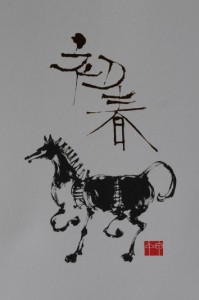 I went to the Loft a few days ago to buy my cards; it seems that there are literally thousands of them sold every day, as the procedure was a bit … unusual. First of all, the real cards are not on display, meaning you can’t just take them. What you get is a large display wall showing the different designs, each one wrapped in a heavy plastic envelope. When you have made your choice(s), you pick up one of those envelopes and go to the cashier, where you are asked how many you want. In the case of the Loft, you can’t buy a single card – you buy them per package, each containing four cards.
I went to the Loft a few days ago to buy my cards; it seems that there are literally thousands of them sold every day, as the procedure was a bit … unusual. First of all, the real cards are not on display, meaning you can’t just take them. What you get is a large display wall showing the different designs, each one wrapped in a heavy plastic envelope. When you have made your choice(s), you pick up one of those envelopes and go to the cashier, where you are asked how many you want. In the case of the Loft, you can’t buy a single card – you buy them per package, each containing four cards.
I paid 540 yen for them and was rather happy with it, after all this is Japan, and prices are steep. The nice cashier explained that because it says “New Year’s Card” on the back, the post office will deliver them on January 1st automatically, and I was relieved that I wouldn’t have to explain this at the post office… This is one of the nice things about those New Year’s cards, if you mail them between December 15th and New Year’s, the post office will deliver them on the right day – in Japan, of course, it won’t work abroad unfortunately. It must be an extremely busy time, I have heard that students and other part time workers are hired just to get all the mail out on January 1st.
You are supposed to send out New Year’s cards to essentially everybody: family, colleagues, teachers of any kind, people you did business with in the last year,… The only people you are not allowed to send a New Year’s card to is those who had a death in the family – the idea is “how can they have a Happy New Year if there is somebody missing?” and it would be rude to wish them one. How do you know that? Well, the bereaved are supposed to send out cards – well before the deadline of course – apologizing that they won’t send any New Year’s cards because of a recent death in the family… Japanese etiquette – truly a minefield…
Anyway, I wrote my cards today and I hope people won’t be offended by the fact that my handwriting in Japanese resembles that of a 5 year old – another one of those etiquette things – nengajo are at least addressed in handwriting to show off your skills in calligraphy – and posted them immediately. The big surprise came at the post office: Apparently the price of the stamp was included in the price of the cards! That means I only had to pay the extra 20 yen for the cards going abroad – what a pleasant surprise!
Sizes
 My Jeans are falling apart. I know that holes in jeans are not necessarily a sign that you should toss them – at least at some point when I was younger it wasn’t – but this hole is at a rather indecent spot for a grown-up woman… Besides it’s winter and it’s cold and the last thing I need right now is extra cooling.
My Jeans are falling apart. I know that holes in jeans are not necessarily a sign that you should toss them – at least at some point when I was younger it wasn’t – but this hole is at a rather indecent spot for a grown-up woman… Besides it’s winter and it’s cold and the last thing I need right now is extra cooling.
Hence, off to town I went, shopping for new jeans. I chose Uniqlo, first because I like their stuff in general, second because they have clothing in great colors, and third because they are an international company (though based in Japan) and know about international sizing. Size is a problem for me when it comes to clothes shopping in Asia. In Europe, I can be considered of normal size, possibly a bit of the short persuasion, but in Asia, quite simply put, I am fat. Not American style grossly overweight, but still fat enough. The other problem is shape. Even when losing another 10 kilos, I would still have (excuse my French) tits and and an ass, which is something the usual Asian – especially the Japanese women – don’t seem to have. They all look like straight ionic columns, while I am distinctly an hourglass, which is quite a problem when shopping because all clothing, even if the size is right, fits above my breasts and below my hips, but not in between. And as I don’t cherish to look eternally pregnant… (okay, I am vain, so? A woman’s prerogative.)
Anyway, I went to Uniqlo because I am so happy with the last sweater I bought there which not only fits perfectly, but is only a size L and not the multiXL I expected. I went to the women’s department and took a look at their jeans – a whole wall full of jeans in various styles and sizes. And again, that’s where the problem started: styles. The vast majority of Japanese girls and women are blessed with something I have not: beautiful legs, long and skinny. And they all know that and enjoy showing them off. Usually that means wearing miniskirts and tights, but every now and then they wear trousers as well – which then fall into the categories “slim, tight, stretch, skinny…”. This doesn’t look good on my at all (vanity again) and besides, I’m not even sure my foot would fit through the opening at the bottom…
Well, this is something I could get over with by the simple observation that I’m buying jeans that I will wear only when running around with my camera and potentially getting dirty. But then I looked at the sizes, conveniently displayed on signs: 21 – 28 inches. That means 53.34 – 71.12 cm of waistline is all that Uniqlo allows a woman to have – in Japan at least – if she wants to wear their jeans. Okay. I have lost a tremendous amount of weight and several sizes when I was in Germany, but 71 cm of waist is something I had when I was a teenager, and the chances of my body reverting to that stage are slim, forgive the pun. I do realize that Uniqlo is geared towards a younger audience, and I do realize as well that I can’t expect them to carry American sizes in the middle of Japan, but I have to say I felt somewhat discouraged. And then I thought, oh what the duck, I’m a gaijin, and went upstairs where there were stacks and stacks of Uniqlo jeans with a great cut in my size. The difference? Men’s department…
Ring
Towards the end of the year, people all over the world like to reminiscence about the year that has passed. Of the Year is an important phrase in this time, and it is added to words like employee, woman, man, person, word, book, movie,… So, let me, without any further ado, present to you the Kanji of the Year 2013: 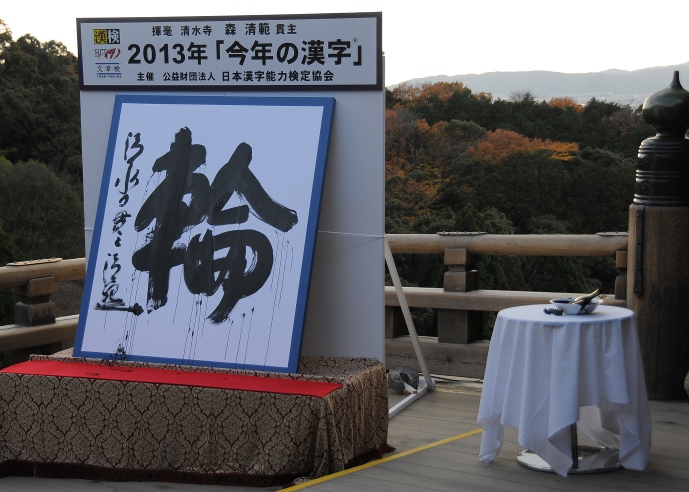
It means ring or wheel and is pronounced as rin or wa, depending on the context. The main reason this character was chosen was that this year, Tokyo has won the bid for the Summer Olympic Games in 2020, something the Japanese are extremely proud of.
Interestingly, choosing a Kanji of the Year is not something invented 1000 years ago! The first such event dates back only to 1995, yes, that’s not even 20 years; this ceremony must feel like the baby amongst all the others celebrated in Japan… 😉 However, it is a very nice ceremony sponsored and organised by the Japanese Kanji Proficiency Society, a private organisation that encourages the use and knowledge of Kanji. People are invited to send in their choice for the Kanji of the Year, and the one with the most votes (this year 9,518 out of 170,290 votes) is then announced, that is, written on a large white board, by the head priest of Kiyomizu temple in Kyoto each year on Kanji Day, December 12.  I went there with a friend to see the ceremony, and it was virtually impossible. At 11:30, the best spots were already taken by journalists, and the not so good spots were guarded by a private security company that told people to move on… We finally secured a place on a viewing platform a little further away and waited in the cold until the ceremony began at 2 pm. Once again, everything was over very quickly. The head priest came, and quickly wrote down the kanji with a brush as thick as my arm (see the first photo above). After a short wait so all journalists could take their pictures, the board was brought into the temple where a small ceremony was conducted. Afterwards, the board was taken out again to take more pictures with the head priest and other celebrities (this was the time for me to sneak up and take my close ups) and then, after maybe half an hour, even before all the journalists had left, everything was taken away and cleaned up again. The whole event was broadcast live on TV; there were even two TVs set up at the temple so people could watch the ceremony at least second hand, and my friend, a distinguished but not unapproachable looking foreigner, was interviewed twice and asked for his opinion on the choice.
I went there with a friend to see the ceremony, and it was virtually impossible. At 11:30, the best spots were already taken by journalists, and the not so good spots were guarded by a private security company that told people to move on… We finally secured a place on a viewing platform a little further away and waited in the cold until the ceremony began at 2 pm. Once again, everything was over very quickly. The head priest came, and quickly wrote down the kanji with a brush as thick as my arm (see the first photo above). After a short wait so all journalists could take their pictures, the board was brought into the temple where a small ceremony was conducted. Afterwards, the board was taken out again to take more pictures with the head priest and other celebrities (this was the time for me to sneak up and take my close ups) and then, after maybe half an hour, even before all the journalists had left, everything was taken away and cleaned up again. The whole event was broadcast live on TV; there were even two TVs set up at the temple so people could watch the ceremony at least second hand, and my friend, a distinguished but not unapproachable looking foreigner, was interviewed twice and asked for his opinion on the choice.
I enjoyed being there, despite the long wait and my frozen toes afterwards. I’m not sure if I’d want to come again next year as I hate being cold, but having my own photos of the event is certainly a nice thing.
A Geisha’s Journey
A Geisha’s Journey: My Life as a Kyoto Apprentice
Komomo and Naoyuki Ogino
 A Japanese teenager living abroad suddenly misses her heritage and identity: What does it mean to be Japanese? On her quest for an answer she discovers the hanamachi, the geisha districts. Enthralled by this fantasy world of beautiful kimono wearing women and ancient customs, she decides to become the most Japanese woman of them all – and enters the hanamachi in Kyoto at age 15 to become a geisha. Given the name Komomo as an apprentice maiko, she starts a demanding training lasting five years to fulfill her dream.
A Japanese teenager living abroad suddenly misses her heritage and identity: What does it mean to be Japanese? On her quest for an answer she discovers the hanamachi, the geisha districts. Enthralled by this fantasy world of beautiful kimono wearing women and ancient customs, she decides to become the most Japanese woman of them all – and enters the hanamachi in Kyoto at age 15 to become a geisha. Given the name Komomo as an apprentice maiko, she starts a demanding training lasting five years to fulfill her dream.
This book tells about those years and gives a glimpse into the intimate details of the hanamachi of Kyoto. Always at Komomo’s side is Naoyuki Ogino, a photographer who is equally fascinated by the flower world and whose striking images of Komomo’s life add an almost magical touch to her story.
Komomo’s story is fascinating, and her change from an insecure teenager to an accomplished Kyoto geiko is obvious in Ogino’s photos. I especially enjoyed learning the little secrets of a geisha’s life. You could probably have guessed that a maiko cannot dress herself alone – but did you know that it takes a man (called the otokoshi) to tie her obi?
Check the book out on amazon.
Numerology
It’s Friday 13th – need I say more?
In Japan, the number 13 is not considered particularly unlucky – that’s a superstition imported from the West. It’s not as if the Japanese are completely free of odd beliefs when it comes to numbers though. The numbers 4 and 9 are considered unlucky. 4 because its Chinese reading is “shi”, and the word for death is also pronounced “shi”. 9 is unlucky because its pronunciation as “ku” sounds like “suffering”. Like in the West, where the number 13 is often avoided in hotels (from floor 12 you go straight to 14) or airlines (no rows 13), the same holds in Japan for the numbers 4 and 9, although it seems to be more common not to have a 4th floor than not to have a 9th. Apparently, planes of All Nippon Airways have no seats with numbers 4 or 9, and many hospitals do not have rooms with these numbers. These beliefs spill over to other areas as well. For example, when giving gifts, you should always take care to give odd numbers – 3 or 5 plates for instance, not 4. For occasions where money is considered appropriate, like weddings, an odd amount (other than 9000) is better than an even one. The best would be a gift of size or amount including 8 though, as 8 is considered a lucky number. The kanji for 8 consists of two strokes that are farther apart on the bottom than on the top, which signifies that a better future lies ahead.
What I find very interesting is that there are lots of odd numbers in many normal packages: Meiji chocolate has 15 little pieces, there are 11 chocolate covered cookies and 5 chocolate buns per pack, and my favourite sweets – chocolate covered macadamia nuts – come in packages of 9 (the suffering is probably in the weight gain). And the last time we opened two 98g packs of chocolate covered almonds – one of them contained 23, and the other one 25. 
Coincidence? I’m not sure. But I might be eating too much chocolate…
Commerce
Today, I wrote Christmas cards to a (very small) number of my friends. It’s about two weeks to go and I’m not in any sort of Christmas mood, to be honest. Part of it is that I’m not religious and that for years already I didn’t receive any presents I hadn’t bought myself. Another part is that Japan does not really lend itself to the Christmas mood: It does not snow (here in Kyoto at least) until well into January if at all, the Japanese are not Christians, nor is there a sizable foreign community that is celebrating it, and the big Japanese thing – New Year’s – is just another week down the line.
It’s not completely ignored either though. A few private houses here do have Christmas decorations (of the gaudy American variety), and through an open window I could see a Christmas tree in a living room last week already. Stores are different of course. Even very small ones have at least some small Christmas decoration, and in the large shopping streets like Shijo or Teramachi or the big department stores like Daimaru and Takashimaya, they almost go overboard, again American style, including the annoying Christmas carols – I even heard the German “O Tannenbaum”…
Anyway, I didn’t even notice what was missing until my friend pointed it out while visiting the Loft yesterday when he said: “It’s all totally commercialized.” And he was right, there is no sense of tradition behind it all – because it is not a Japanese tradition. No baking cookies, no waiting for the snow, no hiding presents for the kids, no mulled wine, no “Adventskalender” or “Adventskranz” as we have it in Austria. It’s just about shopping and spending money. At least, they are totally honest about it…
Needles
I am not sure whether this is a genuinely Japanese thing, or if it is something of the Eastern culture in general, but I have to say, there are all sorts of … interesting religious ceremonies around… Yesterday I went to Horin-ji temple in the Arashiyama district of Kyoto, where a memorial service for needles was held, needles as in sewing needles. The ritual appears to date back to the Heian era, even today people bring their used or even broken needles to this temple and pray for better sewing skills and a happy family.
The ceremony took place in the main hall of the temple and started – after four women with colorful dresses and beautiful hair ornaments and a number of priests had entered and seated themselves – with a short performance of traditional music. Then, the head priest who was sitting in front of the altar started reading or rather chanting a long incantation or prayer in a loud voice. When he was finished the other priests placed themselves in front of the altar and, also chanting, threw little oval pieces of paper over their shoulders to the people sitting behind them. The paper was about the size of a palm and had an image of the Buddha on one side; apparently it is a charm and the way it is distributed is meant to resemble falling leaves. Anyway, those leaves were readily snatched up by the worshippers, and the dancers also distributed some. Their big performance was shortly afterwards, when they started dancing a very slow traditional dance to traditional music. 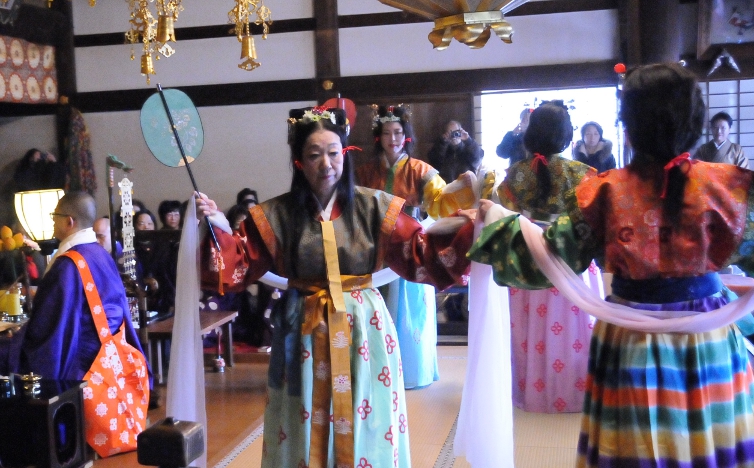 When the dance was over – it started and ended with a bow to the altar – more chants were intonated, but all of a sudden and without warning, permission was given to start the actual needle ceremony: A number of large needles with colorful threads had been prepared as well as blocks of what I first thought was wax (it turned out to be much softer, like jelly, but I have no idea what it really was), and people were invited to take one of the needles and stick them into the blocks while saying their prayers.
When the dance was over – it started and ended with a bow to the altar – more chants were intonated, but all of a sudden and without warning, permission was given to start the actual needle ceremony: A number of large needles with colorful threads had been prepared as well as blocks of what I first thought was wax (it turned out to be much softer, like jelly, but I have no idea what it really was), and people were invited to take one of the needles and stick them into the blocks while saying their prayers. 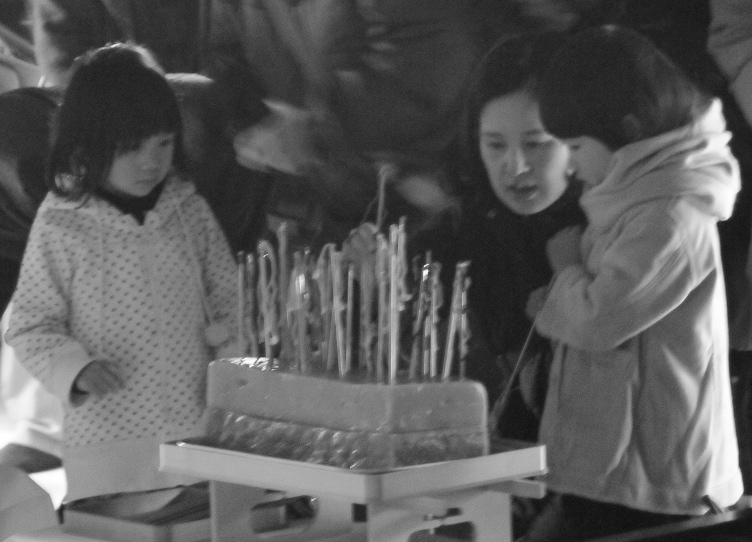 That was the main part of the ceremony, and most of the people left immediately afterwards. They did not hear the final piece of music or saw the women and priests clean up and leave. They also did not notice when two of the dancers returned to do their own needle ceremony. Once again, I found this very strange, but then again, the whole idea of a service for needles is a bit … special, isn’t it?
That was the main part of the ceremony, and most of the people left immediately afterwards. They did not hear the final piece of music or saw the women and priests clean up and leave. They also did not notice when two of the dancers returned to do their own needle ceremony. Once again, I found this very strange, but then again, the whole idea of a service for needles is a bit … special, isn’t it?
Geisha
I guess that the top three things associated with Japan are sushi, samurai, and geisha. While sushi is easily available all over the world these days, and samurai are readily identified as men with swords and that extra bit of honour, the world of the geisha is even nowadays a carefully guarded one where not everybody is allowed to enter, lest take part. This, as well as the fact that the hanamachi (geisha districts, literally “flower town”) are operating with ancient rules and traditions, the meaning of which has long been lost to the outside observer, has given rise to a number of misconceptions and misunderstandings even among Japanese.
It starts with the name: geisha means literally “art person”, she is a woman trained in a number of traditional Japanese arts and plays the part of hostess at parties generally visited by men. She is there to entertain the guests with singing, dancing, witty conversation, general attentiveness, and just the right amount of flirtation; in short, she is there to embody that image of the perfect woman every man fantasizes about – the perfect unattainable woman, because she will always go home alone. Like in many traditional Japanese arts, the first geisha were men, as women were not allowed to go to parties and mingle with men. In the 18th century however, women began to appear as geisha (how this came to pass is unclear), and they quickly became very popular of course. Geisha were independent and worked for themselves, and the brothels or oiran felt threatened by what they saw as competition. So, the government set up rules what geisha were allowed to wear, and how, where, and when they could entertain. Instead of curbing the business, however, this only fanned the flames, and geisha became hugely popular – in the 1920s, there were about 70.000 geisha all over Japan.
Like in many traditional Japanese arts, the first geisha were men, as women were not allowed to go to parties and mingle with men. In the 18th century however, women began to appear as geisha (how this came to pass is unclear), and they quickly became very popular of course. Geisha were independent and worked for themselves, and the brothels or oiran felt threatened by what they saw as competition. So, the government set up rules what geisha were allowed to wear, and how, where, and when they could entertain. Instead of curbing the business, however, this only fanned the flames, and geisha became hugely popular – in the 1920s, there were about 70.000 geisha all over Japan.
In these old days, girls as young as five or six started working and training at an okiya (geisha house). Not few of them were sold by their poor parents to the okiya and had to work there until they could repay the costs for their training. Nowadays becoming a geisha is a normal, albeit somewhat rare career choice for a girl. They usually enter an okiya at 18 (in Kyoto at 16) and start the demanding training of five years until they – at least the most determined ones of them – give their debut as geisha.
A typical training begins with the application of the girl to the okasan (mother) of an okiya. If she is accepted, the okasan will pay for her training and also act as her manager, and the girl will move into the okiya as a shikomi, essentially a maid helping around the house. She will now try to find a mentor among the geisha in the okiya, and once she has been accepted by her onesan (older sister), the so called misedashi ceremony will turn her into a maiko, an apprentice geisha. This is the time when she adopts a stage name that will be hers throughout her career, and often the geisha in an okiya share the first syllable of their stage names. 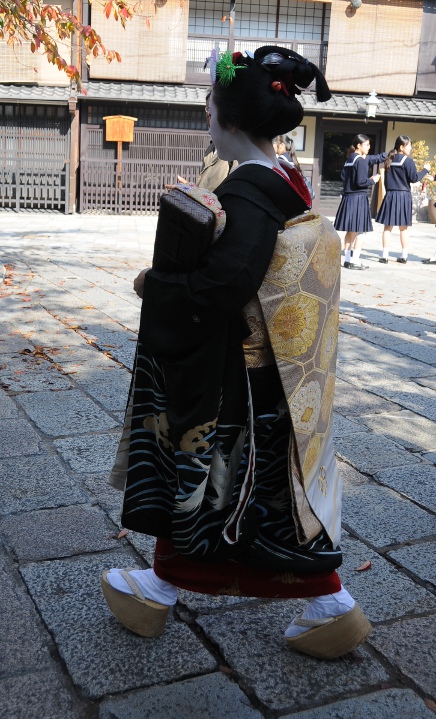 Part of a maiko’s training will be conducted at a kaburenjo, a training school for geisha, where different types of art are taught: ikebana (flower arranging), shodoh (calligraphy), sadoh (tea ceremony), and traditional Japanese dance and music (shamisen, koto, fue, etc.). Another part of the training is learning to speak the dialect of the local hanamachi, and how to entertain all types of men and what to do at parties in general. For that, the maiko will accompany her onesan, but does this only to observe – and to be introduced and to make connections for her future career. Finally, there are intricacies of polite Japanese behaviour to learn: whom to greet first for example, or how deep to bow. This happens mainly by interacting with the other people in the hanamachi, by visiting other okiya or teahouses, for example.
Part of a maiko’s training will be conducted at a kaburenjo, a training school for geisha, where different types of art are taught: ikebana (flower arranging), shodoh (calligraphy), sadoh (tea ceremony), and traditional Japanese dance and music (shamisen, koto, fue, etc.). Another part of the training is learning to speak the dialect of the local hanamachi, and how to entertain all types of men and what to do at parties in general. For that, the maiko will accompany her onesan, but does this only to observe – and to be introduced and to make connections for her future career. Finally, there are intricacies of polite Japanese behaviour to learn: whom to greet first for example, or how deep to bow. This happens mainly by interacting with the other people in the hanamachi, by visiting other okiya or teahouses, for example. 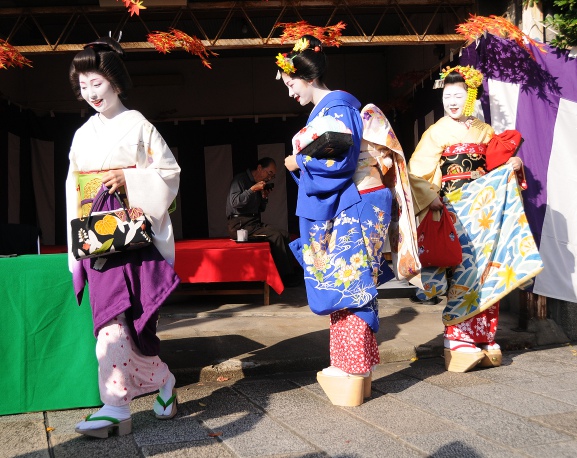 Once the training of a maiko is completed, she will make her debut as a geisha after a ceremony called eriage, which literally means “turning the collar” of her underkimono from a red to a white one. This is only one way of distinguishing maiko and geisha. The appearance of a maiko is usually that of a young girl, with very colourful kimono and bright obi. A maiko’s kimono has long sleeves that almost reach to the floor; most often they wear their obi in a long dangling style to show off the pattern. To avoid trailing the expensive kimono on the floor, they must wear 10 cm high wooden okobo, and a part of their earliest training consists of learning how to walk in them. Maiko also have an elaborate hairstyle that includes many colourful hair ornaments and is difficult to maintain.
Once the training of a maiko is completed, she will make her debut as a geisha after a ceremony called eriage, which literally means “turning the collar” of her underkimono from a red to a white one. This is only one way of distinguishing maiko and geisha. The appearance of a maiko is usually that of a young girl, with very colourful kimono and bright obi. A maiko’s kimono has long sleeves that almost reach to the floor; most often they wear their obi in a long dangling style to show off the pattern. To avoid trailing the expensive kimono on the floor, they must wear 10 cm high wooden okobo, and a part of their earliest training consists of learning how to walk in them. Maiko also have an elaborate hairstyle that includes many colourful hair ornaments and is difficult to maintain.
One of the things many maiko choose to do once they turn into a geisha is to cut off their hair and wear wigs instead. This saves them hours at the hairdresser’s each week, and now they can use real pillows instead of the tiny ones that allow no movement that could destroy the hairdo in the night. In general, a geisha’s appearance is more subdued than that of a maiko, as a geisha represents a mature woman. A geisha’s kimono is less ornate and colourful, the sleeves are much shorter, and the obi is worn in a more compact way. Another boon of being a geisha is that the more simple kimono now allows them to wear normal zori sandals, instead of the okobo. 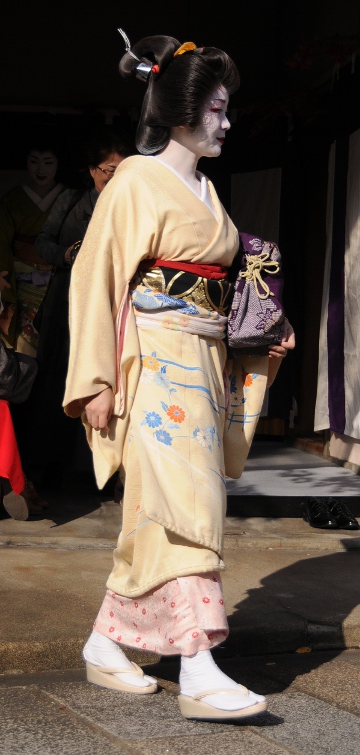 These are the most obvious changes from maiko to geisha, but there are many little details only the truly initiated can spot. Maiko’s hairstyles and collar patterns change from year to year; the more mature a maiko or geisha, the less flaunting her kimono becomes as she is now able to rely on her skills rather than to impress with her dress; and there are people who can tell, just by looking at the kimono and hair ornaments of a maiko which month of the year it is.
These are the most obvious changes from maiko to geisha, but there are many little details only the truly initiated can spot. Maiko’s hairstyles and collar patterns change from year to year; the more mature a maiko or geisha, the less flaunting her kimono becomes as she is now able to rely on her skills rather than to impress with her dress; and there are people who can tell, just by looking at the kimono and hair ornaments of a maiko which month of the year it is.
Nowadays, geisha are not only accomplished entertainers, but also smart businesswomen. In fact, the hanamachi are entirely run by women – from the maiko, their big sisters and mothers, to the owners of the teahouses that employ them. All geisha are unmarried but I guess boyfriends are allowed these days. A geisha getting married marks the time of her retirement, which is celebrated by the final ceremony of hiki iwai. She may now stop taking classes and can move out of her okiya. Often, however, retired geisha open their own teahouse or okiya and stay in the hanamachi in this capacity.  A private evening with a geisha is almost prohibitively expensive, which may be one reason why the number of geisha is dwindling – there are less than 1000 in Japan these days, mostly in Kyoto and Tokyo. There are some public performances throughout the year though, and occasions where you can see maiko and geisha walking the streets on the way to their work, especially in Kyoto’s Gion district. The photos here were taken at a public ceremony last month, by the way.
A private evening with a geisha is almost prohibitively expensive, which may be one reason why the number of geisha is dwindling – there are less than 1000 in Japan these days, mostly in Kyoto and Tokyo. There are some public performances throughout the year though, and occasions where you can see maiko and geisha walking the streets on the way to their work, especially in Kyoto’s Gion district. The photos here were taken at a public ceremony last month, by the way.


